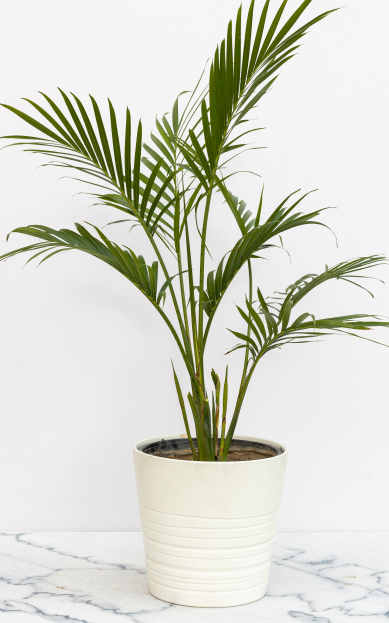
Bring the jungle indoors with lush, feathery elegance
The Cat Palm (Chamaedorea cataractarum), sometimes called the Cascade Palm, is a lush, non-toxic palm that brings tropical vibes and gentle greenery into your home. With its feathery, arching fronds and dense, bushy growth, it’s a beautiful and pet-safe alternative to taller, more dramatic palms like the Areca or Kentia.
Native to the warm, humid forests of southern Mexico and Central America, the Cat Palm makes a low-maintenance indoor plant when given the right conditions. It’s perfect for brightening up corners, softening room lines, or adding a natural touch to an office space.
Cat Palms thrive in bright, indirect light. They do best near an east-facing window or a few feet from a sunny southern or western window with filtered light.
While they can tolerate lower light, growth may slow, and the plant can become leggy or sparse. Avoid direct sun, which can cause the delicate fronds to scorch or turn yellow.
Cat Palms prefer consistently moist (but not soggy) soil. Water when the top 1–2 inches of soil feel dry, typically every 7–10 days, depending on the season and your indoor climate.
Use pots with drainage holes, and avoid letting the plant sit in water. Overwatering can lead to root rot, while underwatering may cause the tips of the leaves to brown and dry out.
These tropical beauties love high humidity. Dry indoor air—especially in winter—can cause frond tips to turn brown. To keep your Cat Palm happy:
Ideal temperature range: 65–80°F (18–27°C)
Avoid cold drafts and temps below 55°F (13°C).
Use a well-draining potting mix that retains some moisture. A potting mix designed for palms or houseplants with added perlite or sand for drainage is ideal.
Cat Palms don’t like to be root-bound, so repot every 2–3 years or when growth noticeably slows. Choose a pot that’s only slightly larger to avoid excess moisture buildup.
Feed monthly in spring and summer using a balanced liquid houseplant fertilizer diluted to half strength. Palms are light feeders, so avoid over-fertilizing, which can cause salt buildup or leaf burn.
Skip feeding during fall and winter when the plant is resting.
Trim off any yellowing or brown fronds at the base to keep the plant looking neat. Regularly dust or gently wipe down the leaves to keep them clean and free of pests.
This palm has a clumping growth habit, so it won’t grow a single tall trunk but will instead form a dense, shrub-like appearance over time.
Great news for pet owners: Cat Palms are non-toxic to cats, dogs, and people. It's one of the best palms to choose for a home with furry friends.